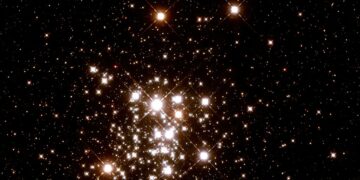Deep in the heart of the Milky Way, hidden behind thick clouds of cosmic dust, lies one of the most mysterious and massive star clusters ever discovered—Westerlund 1. This super star cluster is a powerhouse of stellar activity, home to some of the biggest and brightest stars in our galaxy. And now, thanks to the Hubble Space Telescope (HST), we are getting our most detailed look yet at this extraordinary celestial giant.
A Cosmic Colossus: What is Westerlund 1?
Westerlund 1 is no ordinary star cluster. It is classified as a super star cluster (SSC)—an extremely dense and young stellar population containing thousands of massive stars. Some of these stars shine a million times brighter than the Sun, while others are two thousand times larger than our own star.
Located about 13,800 light-years away, Westerlund 1 is estimated to have a total mass between 50,000 and 100,000 Suns. To put that into perspective, it is one of the most massive and youngest clusters in our galaxy, formed just 5 to 10 million years ago—an infant by cosmic standards!
Why is Westerlund 1 Special?
- It contains some of the largest and most luminous stars in the galaxy.
- It offers a rare look at a dense stellar nursery where young stars evolve under extreme conditions.
- It serves as a laboratory to study starburst clusters, similar to those found in distant galaxies.
- It may help scientists understand the early universe, as many galaxies in the distant past formed similar massive clusters.
Hubble’s Breakthrough: Mapping the Structure of Westerlund 1
Using Hubble’s Wide Field Camera 3 (WFC3), astronomers conducted a multi-epoch study of 10,346 individual stars in Westerlund 1. By carefully measuring the proper motions of these stars, researchers have uncovered a detailed map of the cluster’s structure.
Key Findings from Hubble:
- Elongated Shape – Westerlund 1 is not perfectly circular, as once thought. It is stretched in a northeast-southwest direction, aligning with the galactic plane.
- High Eccentricity – The cluster has an eccentricity of 0.71, meaning it is significantly stretched, likely inherited from the molecular cloud that birthed it.
- Mass Segregation – The most massive stars are concentrated toward the core, while smaller stars are spread throughout the cluster.
A Cluster on the Brink: Dynamics and Mass Segregation
Massive clusters like Westerlund 1 are not static—they evolve over time, with stars interacting and redistributing themselves. One of the most fascinating findings from the Hubble study is how Westerlund 1 is dynamically unstable.
One of the biggest surprises is that Westerlund 1 has a lower velocity dispersion than expected, measuring only 3.42 km/s. This means the cluster is subvirial, indicating that:
- The stars are not moving fast enough to be in equilibrium.
- The cluster may eventually collapse or disperse over time.
- It likely had an exceptionally high star formation efficiency, exceeding 56%.
This suggests that Westerlund 1 was formed through an explosive burst of star formation, followed by the rapid expulsion of excess gas before the stars could settle into a stable orbit.
What Can Westerlund 1 Teach Us About Star Formation?
Understanding Westerlund 1 is critical for solving major astrophysical questions, particularly about how massive stars and star clusters evolve.
How Do Super Star Clusters Form?
Westerlund 1 may be a prototype for super star clusters (SSCs) found in distant galaxies. These clusters are responsible for starburst activity, where an enormous number of stars form in a short time.
The Link to Black Holes
Astronomers believe that some of Westerlund 1’s most massive stars may collapse into black holes within the next few million years. Studying these stars now could help us predict how black holes form from massive star clusters.
A Galactic Laboratory
Because Westerlund 1 is so close compared to other SSCs, it allows astronomers to study these extreme environments in much greater detail.
Conclusion: Why Westerlund 1 Matters
The Hubble Space Telescope’s latest observations of Westerlund 1 have reshaped our understanding of massive star clusters. From its elongated shape and subvirial motion to its unique stellar dynamics, this super star cluster is a cosmic powerhouse of discovery.
Reference:
Structure and Dynamics of the Young Massive Star Cluster Westerlund 1

















